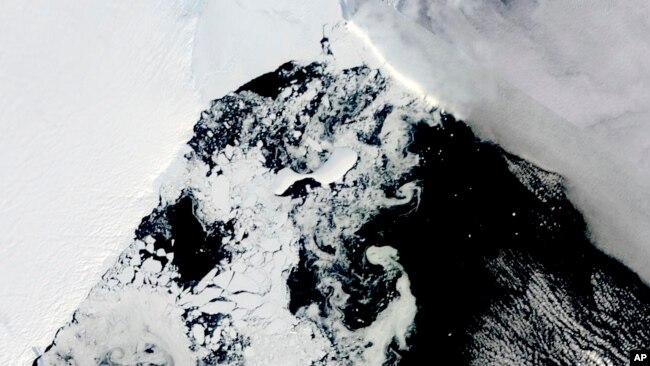消えゆく世界最大の南極氷床
何年も前から分かっていたことです。
経済か生命か? これってそんなに難しいことですか?
VOAで英語を学びましょう!!
研究者たち 世界最大の氷床が融解する危険性(和訳)
Researchers: World’s Largest Ice Sheet Risks Melting
August 14,2022
国際的な科学者たちは、南極にある世界最大の氷床は、彼らが考えていたよりもはるかに急速に氷を失っていると警告しています。
オーストラリア人研究者らによる最近の研究では、地球の気温上昇を抑えるための目標が達成されなかった場合に起こりうることが説明されました。
ネリリー・エイブラム氏は、オーストラリア国立大学地球科学研究科の教授で、最近出版されたネイチャー誌に掲載された研究の共同執筆者です。彼女は、東南極氷床の融解は悲惨なことになりかねないと警告しました。
エイブラム氏は、「2500年までに、東南極は、グリーンランドと西南極からすでに受けている海面上昇に加え、最大5メートルの海面(上昇)に寄与する可能性があります。 」と言っています。
東南極氷床は、世界の氷河の大半の氷を保持しています。西南極やグリーンランドの氷床と比べ、世界的な気温上昇の影響を受けにくいと考えられていました。
エイブラム氏らの研究によると、気温上昇が2℃に抑えられれば、東南極氷床は安定を保つはずだと言います。言い換えれば、概ね同じ大きさを保つはずです。しかし、研究者たちは、気温が上がれば融解が進み、世界の海面が何メートルも上昇する可能性があると警告しています。
エイブラム氏は、「2度の温暖化レベルを超えないように、できる限りのことをする確実に実行する理由がさらに増えました。」 と述べています。
2015年に署名されたパリ気候協定は、地球温暖化を2度未満に抑えることを目標としています。
NASAの研究
Natureに掲載された別の南極大陸の研究は、カリフォルニア州にあるNASAのジェット推進研究所(JPL)の科学者たちの研究から得られたものです。この研究により、東南極氷床の端では、自然のプロセスによる氷の交換よりも速く氷が減少していることが明らかになりました。
氷床の端は棚氷と呼ばれます。棚氷は氷床から水中へ伸びています。それらは、凍結した凍結の永久的な浮氷です。
棚氷の形成には数千年かかます。氷棚が氷河を抑えています、さもなければ氷河が海に落ち海面が上昇するでしょう。
JPLの研究では、研究者は南極の海岸線5万キロメートル以上を調査しました。その結果、沿岸の氷河のかけらが海に落ちることによる氷の損失は、大陸の大きな棚氷が薄くなることによる氷の損失とほぼ同じであることがわかりました。氷が薄くなるのは、その下の海水が暖かくなった結果です。
この2つのプロセスを合わせると、1997年以降、南極大陸の棚氷の質量は12兆トンも減少したことになります。これは、以前の推定値である6兆トンの2倍です。
この研究の主執筆者であるJPLの科学者チャド・グリーンは、「南極大陸はその端から崩れていっています。」と言います。
エリック・ウルフ氏 はイギリスのケンブリッジ大学の教授です。彼はJPLの研究について、「パリ協定が約束する2度の温暖化を守れば、東南極氷床による海面上昇は控えめになるはずです。」と述べています。
しかし、地球温暖化を抑制し、温室効果ガスの排出を減らすことができなければ、今後数世紀にわたって”何メートルもの海面上昇”が起こる危険性があると、彼は言っています。
Researchers: World’s Largest Ice Sheet Risks Melting
International scientists warn that the world’s largest ice sheet in Antarctica is losing ice much more quickly than they had thought.
A recent study by Australian and other researchers described what could happen if targets to limit global temperature increases are not met.
Nerilie Abram is a professor at the Australian National University’s Research School of Earth Sciences. She was a co-writer of a study that recently appeared in the publication Nature. She warned that the melting of the East Antarctic Ice Sheet could be disastrous.
Abram said, “By 2500, East Antarctica could contribute up to 5 meters of sea level [rises] on top of the sea level rise that we will already have had from Greenland and West Antarctica.”
The East Antarctic Ice Sheet holds the majority of world’s glacier ice. It was thought to be less affected by worldwide temperature rises compared to the ice sheet in West Antarctica or Greenland.
The study by Abram and other researchers says that if the temperature rise is limited to 2 degrees Celsius, the East Antarctic Ice Sheet should remain stable. In other words, it should remain generally the same size. But the researchers warn that warmer temperatures could cause more melting and increase worldwide sea level by many meters.
Abram said, “It gives us even more of a reason to make sure that we are doing everything that we can to not exceed that 2-degree warming level.”
The Paris Climate Agreement, signed in 2015, aims to limit global warming to under 2 degrees Celsius.
NASA study
Another Antarctica study published in Nature drew from research by scientists at NASA's Jet Propulsion Laboratory (JPL) in California. The scientists found that the edge of the East Antarctic Ice Sheet has been losing ice faster than natural processes can replace it.
The edges of an ice sheet are known as ice shelves. They extend from the ice sheet into the water. They are permanent floating sheets of frozen freshwater.
Ice shelves take thousands of years to form. They hold back glaciers that would otherwise easily fall into the ocean and cause sea levels to rise.
For the JPL study, the researchers examined over 50,000 kilometers of the Antarctic coastline. They found that the loss of ice from coastal glacier pieces breaking off into the ocean was nearly the same as the loss of ice due to thinning of the continent’s large ice shelves. The thinning of the ice is a result of warming ocean water underneath.
Taken together, the two processes have reduced the mass of Antarctica’s ice shelves by 12 trillion metric tons since 1997. That is double the earlier estimate of 6 trillion metric tons.
“Antarctica is crumbling at its edges,” said JPL scientist Chad Greene, a lead writer of the study.
Eric Wolff is a professor at the University of Cambridge in Britain. He said of the JPL study, "if we keep to the 2 degrees of global warming that the Paris agreement promises, the sea level rise due to the East Antarctic ice sheet should be modest.”
But, he said, failure to limit global warming and reduce greenhouse gas emissions, would risk "many meters of sea level rise over the next few centuries.”
Words in This Story
contribute - v. to help to cause something to happen
stable - adj. in a good condition that is not likely to change
glacier - n. very large area of ice that moves slowly down an area
crumble - v. to break into small pieces
modest - adj. not very large in size or amount

